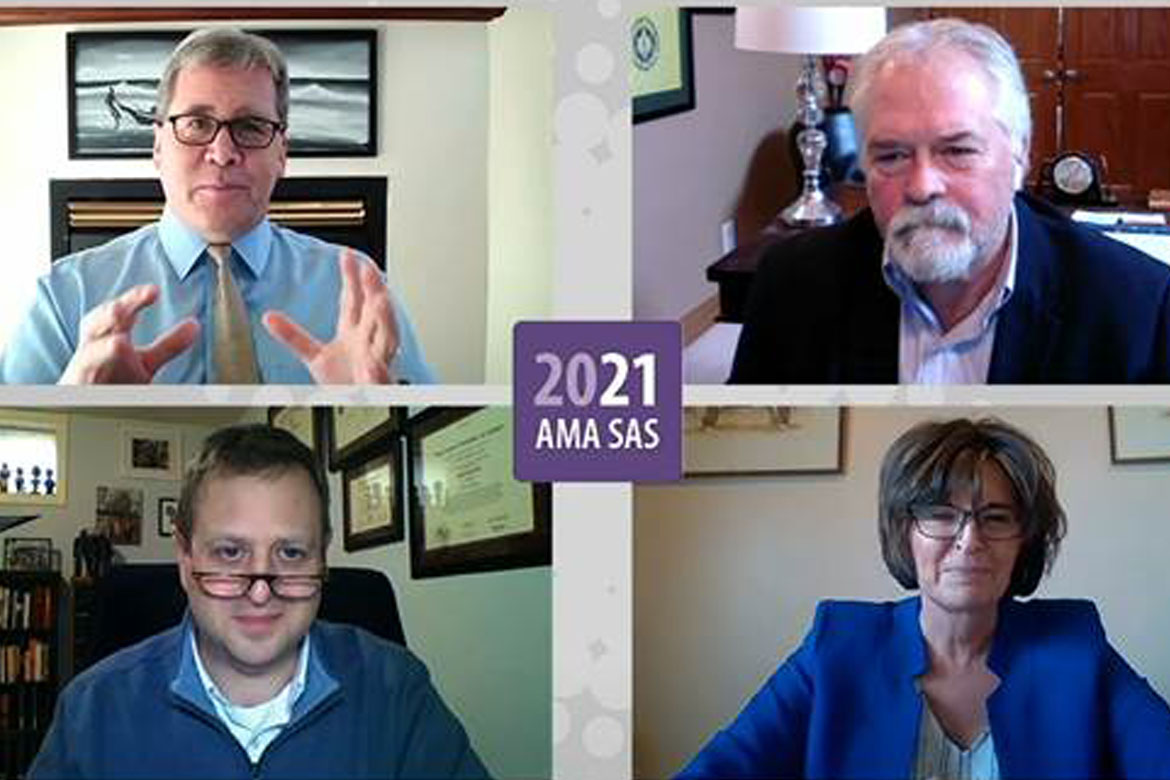Physician advocates seeking to speak with state legislators can no longer pull lawmakers aside for quick consult during a floor debate or explain their position as they walk from one meeting to the next. Instead, much of the work has be done online and well in advance of a bill being introduced due to pandemic-related safety precautions.
“My best advice is to maintain communication,” said Indiana state Rep. Brad Barrett, MD. “Whether it’s a FaceTime call or a cellphone call, we’re walking around with the technology in our pockets. Now is the time to use it.”
Although nonverbal communication may be diminished—no handshakes, less body language to read—the retired general surgeon and now Republican lawmaker from East Central Indiana said that technology has increased citizen access to legislators. It’s also made him more effective with the ability to line up several Zoom meetings a day without having any travel concerns.
Dr. Barrett and other state legislators discussed the nuances of lawmaking during a pandemic and their 2021 legislative agendas during a panel discussion at the 2021 AMA State Advocacy Summit, held virtually this year because of the pandemic.
Patrick Hope, a Democratic member of the Virginia House of Delegates, noted that online hearings have made it easier for citizens to testify and share their views without traveling or having to miss as much work.
Panel moderator Tim Storey, executive director of the National Conference of State Legislatures, noted that there are 99 state legislative chambers (Nebraska only has one), and there have been seemingly just as many approaches to conducting their state’s business—with some states utilizing “an enormous amount of plexiglass.”
Idaho Rep. Laurie Lickley, a Republican who serves on the Health and Welfare Committee, noted that she was one of only about 20% of Idaho lawmakers who wore a mask when the legislature met in August, prompting some to shield their desks with plexiglass.
Read more about the AMA State Advocacy Summit, where the pandemic topped the advocacy agenda but wasn’t the only item of business.
Legislators adapt to new roles
While the Virginia legislature met virtually between August and October, Dr. Barrett said Indiana’s is meeting now for the first time since March. The state’s pandemic response has been implemented through executive orders from Gov. Eric Holcomb, further changing the role of legislators.
“We were all ombudsmen for our constituents,” said Dr. Barrett, who chairs the Indiana House Public Health Committee. “Our role became messengers between the small business community and the local hospital and the county health department, back to our resources.”
Now he and his colleagues are back in session and will review which of the governors’ executive orders to maintain, including those intended to facilitate telehealth adoption and medical licensing with adjacent states.
Similarly, Lickley said Idaho Gov. Brad Little suspended 130 different rules to facilitate telehealth, while Hope commented that “telemedicine has been a godsend.”
Hope, a lawyer and the executive director of the Medical Imaging and Technology Alliance, said health insurance affordability will be a key issue when the Virginia legislature meets.
“My crystal ball is extremely muddy,” Lickley said. But she said addressing Idaho’s high suicide rate and financing Medicaid expansion, which voters approved in 2018, will be top concerns.
“Idaho really takes a balanced budget very seriously,” she added, noting there will be an emphasis on preventing health problems rather than on expensive treatments.
Dr. Barrett noted that hospital costs in Indiana “have drifted up” and that health care value is one of his concerns—along with improving quality.
“I think the No. 1 thing is to have the ultimate filter be that everything we do increases quality of care in the state,” he said.
Learn why the AMA backs new approaches to cover more of the uninsured.
More fights on scope of practice expected
All three legislators predicted scope-of-practice battles ahead. Hope said some nonphysician health professionals will seek to expand their scope of practice during the continuing public health emergency in an effort to not let a “crisis go to waste.”
“If you expand scope, it’s to their level of training and no more,” Hope said.
Indiana may consider a truth-in-advertising bill regarding health care services and how people market themselves, Dr. Barrett said, adding that a “doctor” may be an MD, DO or PhD, and “all bring something different to the table.”
Patients deserve care led by physicians—the most highly educated, trained and skilled health care professionals. Through research, advocacy and education, the AMA vigorously defends the practice of medicine against scope-of-practice expansions that threaten patient safety.




